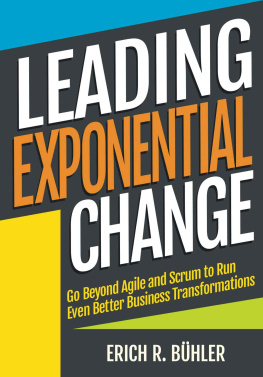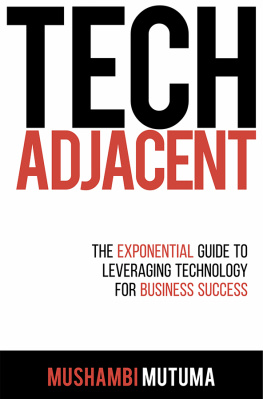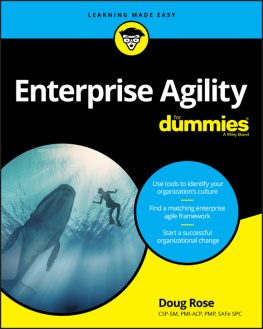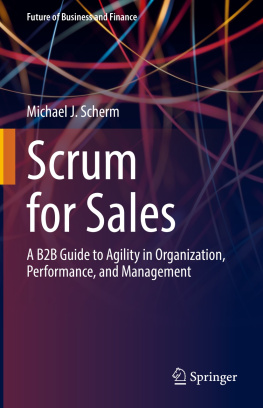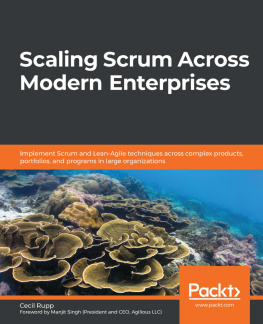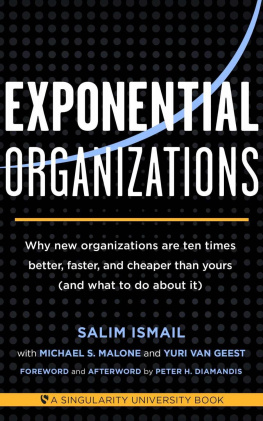The initial drafts of this book, in both Spanish and English, have passed through multiple hands and undergone several revisions. Each revision provided me with invaluable feedback from the following collaborators. Their contributions enabled me to include additional concepts, refine ideas, increase my focus, and add clarity.
Without their support, this work wouldnt have evolved into the book you are now reading.
Stefan Sohnchen (New Zealand), Business Agile consultant. I thank Stefan for his keenly critical eye on every word written in this book. His questions about the ideas shared in this book, along with his professional insight and recommendations, led to many improvements.
Carol Libenson (Venezuela), proofreader and editor. Carol worked on the Spanish version, making it easier to read. She also provided excellent suggestions and ideas for enhancing the content.
Michelle Masella (USA), SpanishEnglish translator. In addition to putting together the initial English draft, Michelle offered suggestions that helped improve both versions of the book.
Adeyinka Adesanya (New Zealand). Thank you, Yinka, for fine-tuning the work.
Victor Marcos (Philippines), book cover designer and typesetter. I thank Victor for his dedication and the time spent away from his family to ensure this book was ready in record time.
James Gallagher (USA), copy editor. James worked on the final draft of the English version, polishing the manuscript and helping to connect readers with the authors vision.
My thanks, as well, to those who contributed their real stories: Carlton Nettleton (USA), Claudia Patricia Salas (Spain), Sebastian Vetter (Germany), Stefan Sohnchen (New Zealand).
Last but not least, thank you, Amparo Snchez , for your unconditional support during the year I invested in making this achievement a reality.
W hy did I choose NOT to write a book about Agile, Lean, or Scrum and choose instead to write about the rules that govern changeand about how these rules can be used for the transition to better, more flexible companies?
Historically, we have thought that evolution is linear and cumulative, that one idea leads to another, and that this next idea will lead to a new discovery. Following this pattern, advances are predictable, and people have time to adapt.
Current technology, though, has changed how evolution takes place, and we are now witnessing exponential change . Companies are facing markets in an accelerated process of change. There is more information available. Consumers are connecting with each other via technology and developing ever more advanced ideas. Computers are increasing in capacity and artificial intelligence. All of this results in greater innovation, but also, in a future that isnt as easy to anticipate as it once was.
Products, especially software, have altered day-to-day activities and changed consumer habits, even in peoples private lives. If you look around, youll notice that many of these products were provided by companies that did not exist a few years ago. Although they may seem to have appeared from out of nowhere, these new companies have succeeded by offering exceptional ideas and services while employing innovative methods for managing employees.
You might think that these companies got lucky, that they were in the right place, at the right time, or that they simply hired some very smart people. But even if all this was true, it would only account for a minor fraction of their success.
These new companies have taken advantage of new market opportunities. They have made use of new technologies, and theyve helped their people feel more comfortable working collaboratively in places with highly varying tasks.
Many of the leaders Ive helped have been paying special attention to these organizations. These leaders realize that change is now a mandatory requirement for facing new challenges.
Just as cloud computing, artificial intelligence and Big Data are essential components in the digital company, so are new ways of thinking, methodologies and frameworks.
Lean, Agile, Scrum, SAFe, LeSS, and Scrum at Scale have helped organizations to grow and improve more quickly, increasing learning and giving clients new possibilities.
With the exception of Lean, these techniques, or mindsets, have been created to improve the development of software products. They are, therefore, difficult to adapt when we want to transform an entire company.
It is no longer enough to understand framework functionalities, principles, or techniques, or new ways to manage people. We must also understand deeper factors of organizational change and learn how these can help entire companies to improve.
Most consultants and leaders agree that changing an organization is an emotional roller coaster. Theres sheer satisfaction when individuals learn and believe the trip was worthwhile, but conflict arises when individuals or teams do not want to change.
On many occasions, people stop supporting the business-transformation initiative, or it loses traction for no apparent reason, making the plan more complex. This happens because human beings are not biologically prepared for constant change. In fact, having to adapt quickly to highly volatile environments increases a persons resistance to change.
Knowing why this happens and having the tricks and techniques to accelerate transformation without a substantial loss of tractionor putting your companys stability at riskis part of what I will convey in this book.
In the following pages, I provide the fundamentals for understanding what happens in highly volatile environments. Relying on psychology and neuroscience applied to organizational change, I have included ideas, techniques, and activities for accelerating your companys transformation.
You will find innovative techniques for coping with resistance to change, recommendations on how to make difficult decisions, and effective ways to prepare the organization for exponential growth.

